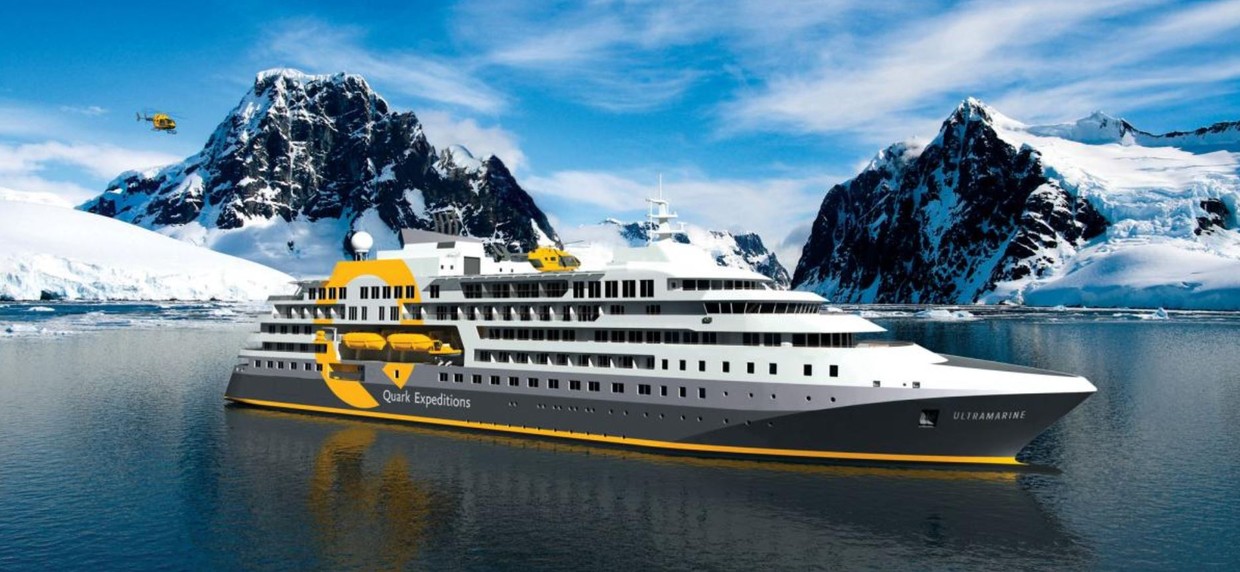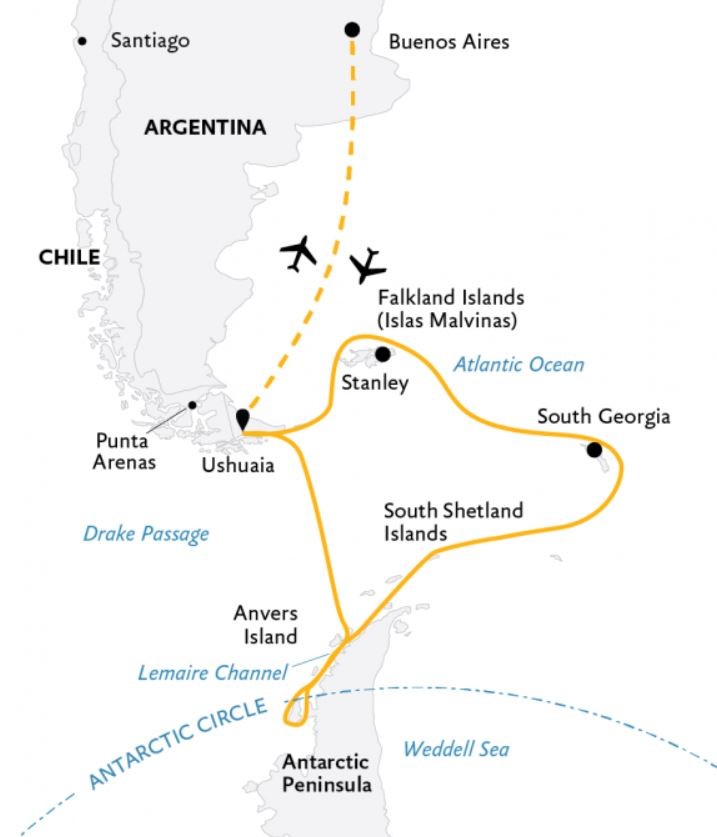2022-01-17
2023-03-31
Note: Current p/p indicative rate. Final price may change due to currency fluctuations.
Our Epic Antarctica voyage is called so for a reason—it includes all of the major Antarctic highlights you can imagine. From the Falkland Islands (Islas Malvinas) to South Georgia to the Antarctic Peninsula, you will have countless unforgettable moments on this adventure-packed, 23-day voyage. Start with the Falklands, reminiscent of both sandy Cape Cod and the English moors, home to albatross, dolphins, and five species of penguins. From there, venture to South Georgia where you’ll enter the home of 300,000 breeding king penguins, 50 million other seabirds and 5 million seals. Then, explore the stunning Antarctic Peninsula, and finally cross the Antarctic Circle—a significant milestone for any world traveler. Starting in 2021, this itinerary allows you to the opportunity to experience our pioneering new vessel, Ultramarine. This purpose-built vessel is designed to extend the boundaries of polar exploration and offer an unmatched Antarctic experience, including a flightseeing tour you’ll never forget and a range of adventure options more extensive than any other ship in its class.
Upon arriving in this splendid city, known for its architecture and rich European heritage, you will independently transfer to your group hotel (pre-expedition hotel night included in mandatory transfer package).
After an early breakfast at the hotel, the group will transfer to the airport and board our private charter flight to Ushuaia, Argentina. Upon arrival, you will be transferred from the airport to a central downtown location to have some time on your own to explore this quaint port town before making your way to the pier. After a late afternoon embarkation, you will sail along the historic Beagle Channel, which transects the Tierra del Fuego archipelago in the extreme south of South America. Expect an air of anticipation as you depart—the next time you see land, you’ll be in a wildlife wonderland!
Your days at sea are filled with presentations led by your Expedition Team photography, wildlife, glaciology, and history. In between presentations, spend time on deck looking for wildlife or chatting with your shipmates over a drink at the bar.
Upon your arrival in the Falklands (Malvinas), your camera will get its first real workout capturing the abundant wildlife and rugged feel of this sub-Antarctic region. The archipelago contains two main islands, East Falkland and West Falkland, which you will explore during daily Zodiac excursions and landings. Stanley, also known as Port Stanley, is often a favored landing site, as the town offers a unique British outpost feel, complete with eclectic charm. You’ll be free to explore, grab a pint at the local pub or visit numerous churches and museums. The Archipelago is rich in wildlife, especially birds, and home to Magellanic, gentoo and southern rockhopper penguins. If you’re lucky, you may even spot king penguins here as well! You can expect to see black-browed albatross, plus two endemic bird species—the flightless Falkland steamer duck and possibly the elusive Cobb’s wren. Your team of lecturers and specialists will be sure to educate you on the local flora and fauna, making the most out of your time in the Falklands.
Sailing southeast to South Georgia, you’ll officially enter Antarctic waters once you cross the Antarctic Convergence, an invisible biological boundary encircling the continent. This meeting of oceans, where the cold Antarctic waters mix and mingle with the warmer waters of the Indian, Pacific and Atlantic Oceans, helps create the abundance of krill that attracts whales and seals to this part of the world. Your Expedition Team will notify you when you cross this invisible yet important line, and also look out for the seabirds and marine life that frequent the area.
This remote, mountainous island was a popular stop for many historic Antarctic expeditions and was once a haven for hunting whales and seals. Today, island wildlife populations are rebounding, but you’ll still see remnants of old whaling stations and other abandoned outposts. One significant and historic site is the grave of the great explorer Sir Ernest Shackleton. You can visit his grave at the settlement of Grytviken, which is also home to an old whaling station, plus a museum, gift shop, church and small research station. Although South Georgia’s history is an important attraction to the island, it is the tremendous abundance of wildlife that you and your shipmates will surely find most captivating. Each landing you make on South Georgia, often referred to as the Galapagos of the Poles, will open your eyes to the wondrous lives of new, enthralling creatures. One day you may see rookeries with hundreds of thousands of pairs of king penguins waddling on a beach, and the next, you may visit another beach blanketed with thousands of fur or elephant seals. The grasses, mountains and beaches of South Georgia all play an important role in the breeding and survival of different species on the island. This fragile and interwoven relationship is something your Expedition Team will explain to you during your time here.
Say goodbye to the king penguins, as your next destination is Antarctica! Your days at sea are filled with presentations, lectures and workshops led by your Expedition Team, who will prepare you for the wildlife that will greet you upon your arrival.
The experience is hard to put into words, but the most common reaction upon reaching the White Continent is a sense of reverence and awe. You will discover that Antarctica is a land of extremes: at one moment you’ll be overcome with a feeling of complete silence and solitude; the next, you’ll be laughing at the comical antics of a curious penguin. Zodiac cruising, visits to historical sites and, of course, communing with seals and penguins are sure to keep you smiling every day. Perhaps you’ll catch sight of the fearless penguin eater, the leopard seal, or maybe you’ll come eye to eye with an Antarctic minke whale while you are cruising in a Zodiac. Each day and each excursion will present a new collection of creatures to delight you and keep your camera busy. If you find yourself wanting more, treat yourself to an optional kayaking adventure (reserve in advance when booking your trip) or a plunge into Antarctic waters!
Crossing the Antarctic Circle is an impressive achievement, as few expeditions reach so far south. If conditions allow us to cross this famed line at 66°33´ S, we’ll toast the first explorers who ventured here, and you can raise a glass and take pride in knowing you’ve made it to a part of the world visited by very few people. This is raw Antarctica, home of the midnight sun and fantastic iceberg sightings.
If you haven’t had your fill of Antarctic wildlife and icebergs by now, you’ll surely be satisfied by the time you return to the Drake Passage. You will continue to make excursions by Zodiac as you travel north along the western Antarctic Peninsula. Your Expedition Team will always be on the lookout for species of seabirds, seals and whales that may have eluded you on your journey south.
After more than three weeks of unique wildlife encounters and remarkable landscapes, your journey home begins. Crossing the Drake is your unofficial rite of passage, putting a final stamp of approval on your Antarctic adventure.
After breakfast aboard the ship, it is time to part ways and say goodbye to your Expedition Team. Airport transfers will be provided for those departing on the first homeward flights. Other guests will be transferred to town.
Embracing the unexpected is part of the legacy – and excitement – of expedition travel. There are no guarantees that we can achieve everything we set out to accomplish. A measure of flexibility is something all of us must bring to a voyage. There are nearly 200 recognized sites in the Antarctic Peninsula and South Shetlands and the places mentioned above may be changed to others equally as interesting.

Vessel Type: Expedition Ship Length: 128 metres Passenger Capacity: 199 Built: 2019-2020 Ultramarine is designed to go beyond the familiar in polar exploration, to discover new places, and to immerse you in the best the region has to offer. Equipped with two twin-engine helicopters, Ultramarine offers the most robust portfolio of adventure activities in the industry, the most spacious suites in its category, breathtaking public spaces, and more outdoor wildlife viewing spaces than other expedition ships its size. It also features an innovative mix of sustainability features that exceed all industry standards. With all this and more, Ultramarine is set to deliver the ultimate polar expedition experience. Cabin - Spacious Entryways, Personal Safes, Spa-inspired Bathrooms, Heated Bathroom Floors, Premium beds and bed linens, Convertible Beds, Individual Temperature Controls, HD Flatscreen Televisions, Oversized Windows With Sweeping Views, Electrical Supply: 220V Aboard - 2 Dining Areas, 4 Bars, Panorama Lounge, Lecture Theater, Library, Polar Boutique, Spa & Fitness Center, Oceanview Sauna, Zodiac Hangar with 4 Embarkation Points, 2 Ready Rooms with Individual Lockers, Walkaround Deck, Bridge Activities - Flightseeing (Included), Zodiac Cruising (Included), Hiking (Included), Lectures (Included), Camping (Optional), Sea Kayaking (Optional), Stand-Up Paddleboarding (Optional), Paddle Excursions (Optional), Cross Country Skiing (Optional), Mountaineering (Optional)
• Flightseeing aboard Ultramarine. While polar landscapes are spectacular from the sea, they’re even more stunning from the air, a view you can enjoy while seated in one of the two twin-engine helicopters stationed on Ultramarine. • Hiking in the polar regions differs from your typical trail experience. Here, in a tree-less terrain, you are the tallest figure on the landscape as you walk over spongy tundra, crusty snow or sandy beaches in remotes parts of the Arctic and Antarctica. • The Polar Plunge is scheduled once during each voyage. Throughout the journey, the Expedition Leader and Captain constantly monitor conditions in order to choose the optimal time and location. The Polar Plunge sometimes takes place onshore or, in many cases, from the gangway or Zodiac. • Zodiacs are used for transferring you ashore, transporting your luggage when necessary and for taking you ocean-level cruising among icebergs, whales and seabirds. During the expedition, you will visit remote and isolated sites that are accessible only by Zodiac.
